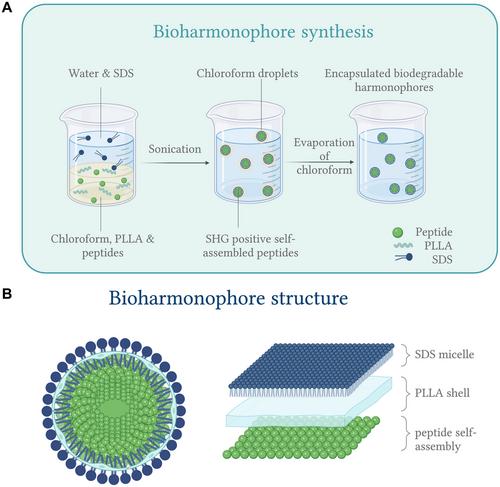Synthesis and Functionalization of Biodegradable Second Harmonic Generation Nanoprobes for Cell Targeting
Edagul Ulucay, Pomone Bollier, Marina Spilioti, Ali Yasin Sonay, Konstantinos Kalyviotis, Periklis Pantazis
{"title":"Synthesis and Functionalization of Biodegradable Second Harmonic Generation Nanoprobes for Cell Targeting","authors":"Edagul Ulucay, Pomone Bollier, Marina Spilioti, Ali Yasin Sonay, Konstantinos Kalyviotis, Periklis Pantazis","doi":"10.1002/cpz1.1089","DOIUrl":null,"url":null,"abstract":"<p>Optical imaging technologies and cell targeting have played a major role in detecting and treating diseases such as cancer. Bioharmonophores are optical imaging nanoprobes composed of biodegradable polymer–encapsulated, self-assembling triphenylalanine peptides. They produce a strong second harmonic generation (SHG) signal, a non-linear optical process in which two photons directed at a non-centrosymmetric medium combine to form a new photon with twice the energy. Bioharmonophores demonstrate superior optical properties compared to fluorescent probes and, unlike previously developed inorganic SHG nanoprobes, are both biocompatible and biodegradable. Here, we present a protocol providing five detailed procedures that describe (1) synthesis of bioharmonophores; (2) embedding and imaging of the synthesized SHG nanoprobes in polyacrylamide gel; (3) functionalization of bioharmonophores with thiol-containing polyethyleneglycol; (4) subsequent click chemistry to target cancer cells; and (5) imaging of functionalized bioharmonophores endocytosed by cancer cells using two-photon microscopy. Bioharmonophores hold great potential as clinical contrast agents due to their optical features and could be used in the future as an innovative approach to cancer treatment using targeted high-resolution optical imaging. © 2024 The Author(s). Current Protocols published by Wiley Periodicals LLC.</p><p><b>Basic Protocol 1</b>: Synthesis of bioharmonophores</p><p><b>Basic Protocol 2</b>: Imaging of bioharmonophores in polyacrylamide gel</p><p><b>Basic Protocol 3</b>: Functionalization of bioharmonophores with thiol-PEG</p><p><b>Basic Protocol 4</b>: Functionalization of thiol-PEGylated bioharmonophores with peptides</p><p><b>Basic Protocol 5</b>: Targeting of cancer cells with functionalized bioharmonophores</p>","PeriodicalId":93970,"journal":{"name":"Current protocols","volume":"4 7","pages":""},"PeriodicalIF":0.0000,"publicationDate":"2024-07-22","publicationTypes":"Journal Article","fieldsOfStudy":null,"isOpenAccess":false,"openAccessPdf":"https://onlinelibrary.wiley.com/doi/epdf/10.1002/cpz1.1089","citationCount":"0","resultStr":null,"platform":"Semanticscholar","paperid":null,"PeriodicalName":"Current protocols","FirstCategoryId":"1085","ListUrlMain":"https://onlinelibrary.wiley.com/doi/10.1002/cpz1.1089","RegionNum":0,"RegionCategory":null,"ArticlePicture":[],"TitleCN":null,"AbstractTextCN":null,"PMCID":null,"EPubDate":"","PubModel":"","JCR":"","JCRName":"","Score":null,"Total":0}
引用次数: 0
Abstract
Optical imaging technologies and cell targeting have played a major role in detecting and treating diseases such as cancer. Bioharmonophores are optical imaging nanoprobes composed of biodegradable polymer–encapsulated, self-assembling triphenylalanine peptides. They produce a strong second harmonic generation (SHG) signal, a non-linear optical process in which two photons directed at a non-centrosymmetric medium combine to form a new photon with twice the energy. Bioharmonophores demonstrate superior optical properties compared to fluorescent probes and, unlike previously developed inorganic SHG nanoprobes, are both biocompatible and biodegradable. Here, we present a protocol providing five detailed procedures that describe (1) synthesis of bioharmonophores; (2) embedding and imaging of the synthesized SHG nanoprobes in polyacrylamide gel; (3) functionalization of bioharmonophores with thiol-containing polyethyleneglycol; (4) subsequent click chemistry to target cancer cells; and (5) imaging of functionalized bioharmonophores endocytosed by cancer cells using two-photon microscopy. Bioharmonophores hold great potential as clinical contrast agents due to their optical features and could be used in the future as an innovative approach to cancer treatment using targeted high-resolution optical imaging. © 2024 The Author(s). Current Protocols published by Wiley Periodicals LLC.
Basic Protocol 1: Synthesis of bioharmonophores
Basic Protocol 2: Imaging of bioharmonophores in polyacrylamide gel
Basic Protocol 3: Functionalization of bioharmonophores with thiol-PEG
Basic Protocol 4: Functionalization of thiol-PEGylated bioharmonophores with peptides
Basic Protocol 5: Targeting of cancer cells with functionalized bioharmonophores

用于细胞靶向的可生物降解二次谐波发生纳米探针的合成与功能化。
光学成像技术和细胞靶向技术在检测和治疗癌症等疾病方面发挥了重要作用。生物谐波探针是一种光学成像纳米探针,由可生物降解的聚合物封装的自组装三苯丙氨酸肽组成。它们能产生强烈的二次谐波发生(SHG)信号,这是一种非线性光学过程,在这一过程中,射向非中心对称介质的两个光子结合在一起,形成一个能量两倍的新光子。与荧光探针相比,生物谐波探针具有更优越的光学特性,而且与之前开发的无机 SHG 纳米探针不同,生物谐波探针具有生物兼容性和生物可降解性。在此,我们提出了一个方案,提供了五个详细步骤,分别描述了:(1)合成生物谐波探针;(2)将合成的 SHG 纳米探针嵌入聚丙烯酰胺凝胶并成像;(3)用含巯基的聚乙二醇对生物谐波探针进行功能化;(4)随后用点击化学方法靶向癌细胞;以及(5)使用双光子显微镜对癌细胞内吞的功能化生物谐波探针进行成像。生物谐波团因其光学特性而具有作为临床造影剂的巨大潜力,未来可作为一种创新方法,利用靶向高分辨率光学成像治疗癌症。© 2024 作者。当前协议》由 Wiley Periodicals LLC 出版。基本方案 1:生物谐波团的合成 基本方案 2:生物谐波团在聚丙烯酰胺凝胶中的成像 基本方案 3:生物谐波团与硫醇-PEG 的功能化 基本方案 4:硫醇-PEG 化生物谐波团与肽的功能化 基本方案 5:用功能化生物谐波团靶向癌细胞。
本文章由计算机程序翻译,如有差异,请以英文原文为准。


